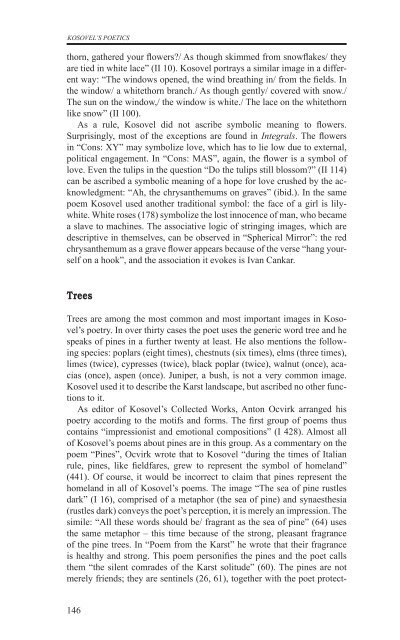razprave (pdf) - Društvo za primerjalno književnost - ZRC SAZU
razprave (pdf) - Društvo za primerjalno književnost - ZRC SAZU
razprave (pdf) - Društvo za primerjalno književnost - ZRC SAZU
- No tags were found...
Create successful ePaper yourself
Turn your PDF publications into a flip-book with our unique Google optimized e-Paper software.
KOSOVEL’s poeticsthorn, gathered your flowers?/ As though skimmed from snowflakes/ theyare tied in white lace” (II 10). Kosovel portrays a similar image in a differentway: “The windows opened, the wind breathing in/ from the fields. Inthe window/ a whitethorn branch./ As though gently/ covered with snow./The sun on the window,/ the window is white./ The lace on the whitethornlike snow” (II 100).As a rule, Kosovel did not ascribe symbolic meaning to flowers.Surprisingly, most of the exceptions are found in Integrals. The flowersin “Cons: XY” may symbolize love, which has to lie low due to external,political engagement. In “Cons: MAS”, again, the flower is a symbol oflove. Even the tulips in the question “Do the tulips still blossom?” (II 114)can be ascribed a symbolic meaning of a hope for love crushed by the acknowledgment:“Ah, the chrysanthemums on graves” (ibid.). In the samepoem Kosovel used another traditional symbol: the face of a girl is lilywhite.White roses (178) symbolize the lost innocence of man, who becamea slave to machines. The associative logic of stringing images, which aredescriptive in themselves, can be observed in “Spherical Mirror”: the redchrysanthemum as a grave flower appears because of the verse “hang yourselfon a hook”, and the association it evokes is Ivan Cankar.TreesTrees are among the most common and most important images in Kosovel’spoetry. In over thirty cases the poet uses the generic word tree and hespeaks of pines in a further twenty at least. He also mentions the followingspecies: poplars (eight times), chestnuts (six times), elms (three times),limes (twice), cypresses (twice), black poplar (twice), walnut (once), acacias(once), aspen (once). Juniper, a bush, is not a very common image.Kosovel used it to describe the Karst landscape, but ascribed no other functionsto it.As editor of Kosovel’s Collected Works, Anton Ocvirk arranged hispoetry according to the motifs and forms. The first group of poems thuscontains “impressionist and emotional compositions” (I 428). Almost allof Kosovel’s poems about pines are in this group. As a commentary on thepoem “Pines”, Ocvirk wrote that to Kosovel “during the times of Italianrule, pines, like fieldfares, grew to represent the symbol of homeland”(441). Of course, it would be incorrect to claim that pines represent thehomeland in all of Kosovel’s poems. The image “The sea of pine rustlesdark” (I 16), comprised of a metaphor (the sea of pine) and synaesthesia(rustles dark) conveys the poet’s perception, it is merely an impression. Thesimile: “All these words should be/ fragrant as the sea of pine” (64) usesthe same metaphor – this time because of the strong, pleasant fragranceof the pine trees. In “Poem from the Karst” he wrote that their fragranceis healthy and strong. This poem personifies the pines and the poet callsthem “the silent comrades of the Karst solitude” (60). The pines are notmerely friends; they are sentinels (26, 61), together with the poet protect-146
















